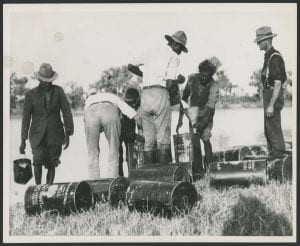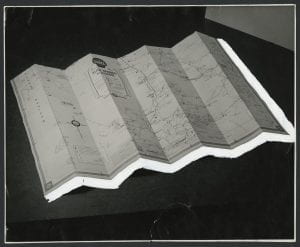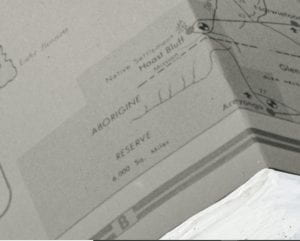The Shell Touring Service – Hidden Indigenous Connections
Austin Tseng
Aboriginal and Torres Strait Islander peoples should be aware that University of Melbourne Collections may contain images, voices or names of deceased persons, or culturally sensitive content.
The Shell Historical Archives possess 86 items pertaining to their Touring Service, consisting of photographs of mapping staff on the road, shots of inland Australia, and photos of maps, map printing and staff in general, dating from 1928 to the 1960s.1 During this period, Shell also advanced the global adoption of the standardized service station across Australia, a concept initially developed in the U.S. in the 1930s.2 Offering essentially the same product to consumers, oil companies needed to stand out from their competition by other means, such as building customer service programs.
The Touring Service notably provided a bespoke mapping and service program for gas-chugging holidaymakers, that were developed according to customer information received from Shell dealerships. The bespoke treatment offered by the Service was essential for fostering customer goodwill towards the company, and was targeted at the growing number of private vehicle owners.3 In what has been called by the historian Graeme Davison, the ‘touring spirit’, the Shell Touring Service facilitated the realization of fantasies that were largely the preserve of the white middle-class.4 While many of the photos are void of ordinary people, focusing more on buildings and roads than individuals, the presence of Indigenous Australia may be felt in certain items from the “Photographs of the Shell Touring Service and Mapping Unit” collection.

This first photo is taken from the Thornycroft Expedition, a 1929 operation to recover the bodies of two lost aviators in Central Australia. Here we see four Aboriginal men assisting two expedition members with filling up barrels of Shell Motor Spirit. The same photo is found in the diary of Leslie S. Miles, the driver-mechanic of the expedition, held by the National Museum of Australia. The diary confirms that the image was taken on June 5th at Newcastle Waters in the Northern Territory. The four Indigenous men were trackers hired by the team, and the barrels were being filled with water for the journey.5 The names of the trackers are Bobby (Bob Jangala), Tommy (Midjanu Jampijinpa), Hughie (Hughie Jampijinpa) and Jack(y) (Jarramirnti Jangari).6 The use of Shell products is apparently what warrants both Shell’s interest in the expedition, and the photo’s inclusion in the Touring Service’s collection – a contention supported by the presence of other expedition photos in the collection (also found in the diary), like Mr. Miles holding a Motor Spirit barrel. Tellingly, another photo of the scene on June 5th is a cropped version of one in Miles’s diary – the original clearly depicts two of the Indigenous trackers, yet the Touring Service’s copy crops out one of them completely as well as the face of the other, in order to center on the expeditions’ truck which is visibly loaded with crates marked “Shell”. The willful erasure of their presence is not uncommon during this period of ‘Assimilation’ and predictably the emphasis on product over people obscures some of the dependencies that may have existed between Indigenous people and the expansion of road routes in central Australia. Indeed, subsequent searches to retrieve the aircraft (the ‘Kookaburra’) made next to no use of Indigenous knowledge, and none of the four trackers from 1929 were ever consulted. Barring an accidental encounter by a surveying party in 1961 (which failed to record the location with any useful degree of accuracy), the Kookaburra was not located and recovered until 1978.7


In these two photos, the product is the hero, be it the Motor Spirit or the touring map. This exemplifies how both advertising and the historical record have often relegated Indigenous presences to near-invisibility, despite the fantasies of mobility that Shell was marketing being built through and on Indigenous land and labour. Such erasure enables a certain ‘heroic’ narrative that has long been part of the nation’s psyche – the land as ‘new’ , and just waiting for newcomers to explore or conquer it.
Austin Tseng is a Chinese settler living on Wurundjeri country. His PhD thesis analyses discourses on Indigenous Australia within Chinese-Australian newspapers over the last century
References
- Page 69 of the Archives List for the Shell Historical Collection describes these items as dating from 1928-60, however the University of Melbourne Archives site lists the dates as c. 1928-69.
- Graeme Davison, Car Wars: How the car won our hearts and conquered our cities, Crows Nest, NSW: Allen & Unwin, 2004, p.92.
- Katie Wood, ‘The Shell Touring Service’. See also Raymond H. Murphy, ‘Touring Service’, Together, Sep.–Oct. 1959, pp. 4–5.
- Graeme Davison, ‘The Touring Spirit’
- Leslie S. Miles, ‘Diary Account of the Thornycroft Expedition into Central Australia to recover the bodies of aviators Anderson and Hitchcock in 1929’, Sharp and Cook Collection, 1929, 1985.0027.0001.001, http://collectionsearch.nma.gov.au/?object=111760
- David Nash, ‘Aboriginal History of the Aeroplane ‘Kookaburra’, Aboriginal History, vol.6 June 1982, pp.61-73.
- Ibid.,
- ‘Haasts Bluff Native Settlement’, Find and Connect, https://www.findandconnect.gov.au/guide/nt/YE00050, last updated 27 November 2020.
Leave a Reply